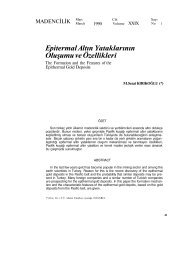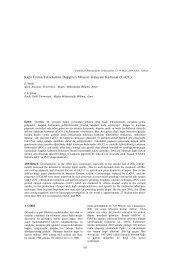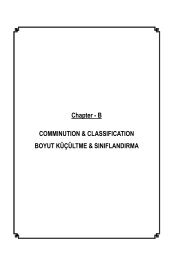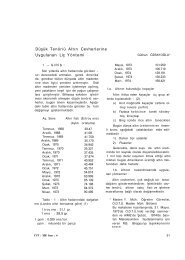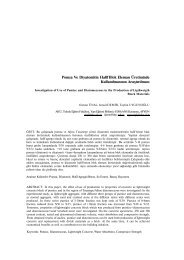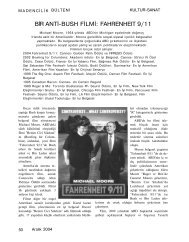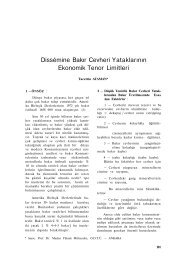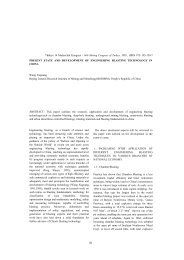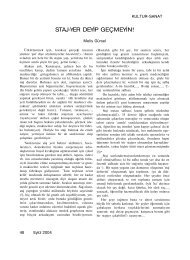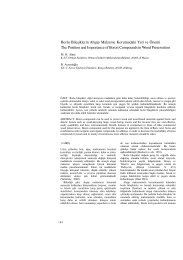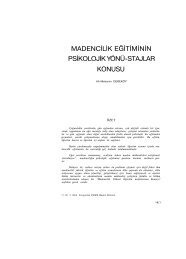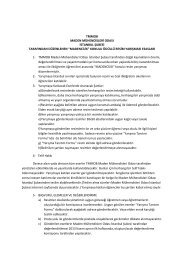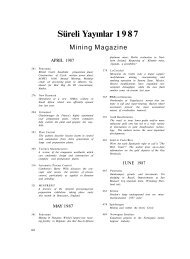A OPEN PIT MINING AÇIK OCAK MADENCİLİĞİ
A OPEN PIT MINING AÇIK OCAK MADENCİLİĞİ
A OPEN PIT MINING AÇIK OCAK MADENCİLİĞİ
Create successful ePaper yourself
Turn your PDF publications into a flip-book with our unique Google optimized e-Paper software.
23 rd <br />
In – Pit Crushing and Conveying (IPCC): An Option to Transport<br />
on Mining That Is Coast Lowering and Sustainable<br />
T. Santos, J. Miranda<br />
Universidade Federal de Ouro Preto, Ouro Preto, Brazil<br />
ABSTRACT Aiming to work sustainably, mining companies all around the world search for<br />
ways to minimize the impacts of mining on the environment. Ore transportation by trucks is<br />
becoming one of the major causes of environmental impacts, due to the fact that it creates a<br />
considerable amount of waste, such as tires and excessive carbon emissions on the<br />
atmosphere. Beyond the environmental issue, the truck transportation method presents high<br />
operational and maintenance costs. Thus, as an alternative to this transport model, emerged<br />
on the decade of 1940 the possibility of carrying ores by conveyor belts and on the decade of<br />
1950 emerged the first mobile crusher, which form together a system called IPCC. This<br />
proposition for transport is becoming a trend on the mining sector. That because the main<br />
issue became a factor of economy and viability of new enterprises along with the principles<br />
of sustainability.<br />
1 INTRODUCTION<br />
Mining emerged in Brazil in the XVIII<br />
century, when Portuguese expeditions,<br />
called entradas e bandeiras, entered the<br />
interior of the country searching for precious<br />
metals. At that time, mining was predatory.<br />
Mining was executed without caring for<br />
environment issues and the main goal was to<br />
bring richness to the Portuguese Crown. Past<br />
the colonial period, mining activities<br />
continued to happen without any concern for<br />
the damage caused to the environment.<br />
The first time the damage mining could<br />
cause to the environment was discussed in<br />
1988 with the creation of the Constitution of<br />
the Federative Republic of Brazil. According<br />
to the Federal Constitution, in its article 225,<br />
subsection IV and paragraph 2, are provided,<br />
respectively, the requirement of previous<br />
study of environmental impact for the<br />
implementation of works or potentially<br />
harmful activities, besides the miner’s<br />
obligations of recovering the degraded<br />
environment, according to the technical<br />
solution required by the responsible public<br />
agency (Constituição, 1988). With the<br />
regulation of mining exploration, nowadays<br />
the companies do not care only about the<br />
production levels, but also about minimizing<br />
the environmental degradation. In the course<br />
of time, the mining sector’s vision has been<br />
suffering positive transformations, as<br />
highlighted Farias, “mining is one of the<br />
basic sectors of Brazil's economy. It<br />
contributes decisively to the welfare and<br />
quality of life improvement of present and<br />
future generations. It is crucial to the<br />
development of an equitable society,<br />
provided it is operated with social<br />
responsibility, and the principles of<br />
sustainable development always present<br />
"(Farias, 2002).<br />
Mining operations consist generally of<br />
dismantling, loading and transportation.<br />
Among these operations, transportation of<br />
165



